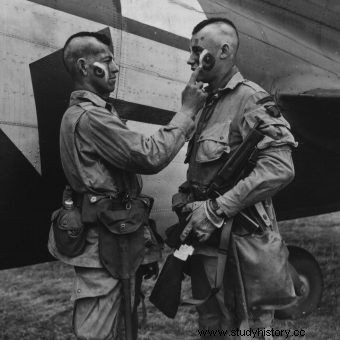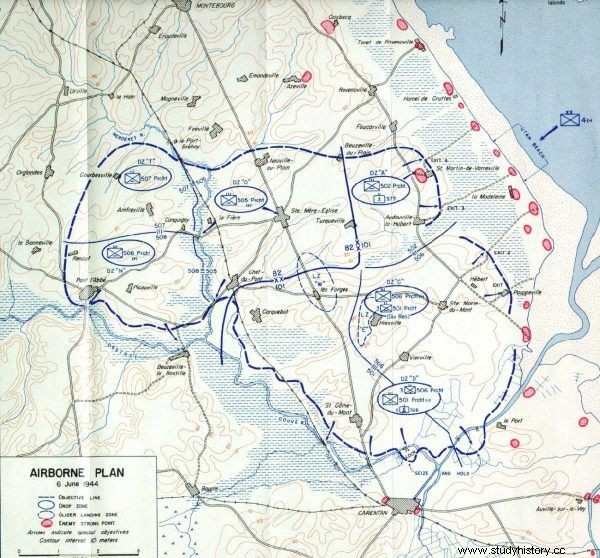The attack on the entrenched and well-armed opponent seemed pure madness. However, Lieutenant Richard Winters and his paratroopers proved that a determined and well-trained unit can work miracles. During the Normandy invasion, their bravery and bravery saved the lives of hundreds of American soldiers.
The American 101st Airborne Division was formed in mid-August 1942. From that moment on, the "Screaming Eagles", as the paratroopers serving in it were popularly called after the symbol of the division, trained intensively for the first combat jump for almost two years.
Their moment came during the Normandy landings. They had one of the key roles to play there.
According to the plans of Operation Overlord, as the Allied invasion of France was called, the divisional troops were directed to the "Utah" beach area. After landing, scheduled for June 6, 1944, around 1 am, they were to take over four narrow dikes running through the marshy area. This would enable the American amphibious troops landing in Utah to leave the beach and continue their advance inland.

Clarence E. Ware painting the face of "Chuck" Plaud. RAF Exter airfield, 5 June 1944
The 101st Division also included the famous "E" company of the 2nd Battalion of the 506th Parachute Infantry Regiment, nicknamed "Easy Company". Its task was to reach the exit of one of these dikes. It was located north of the village of Pouppeville, about 10 kilometers from Sainte-Mère-Église. However, when the appointed day came, it turned out that the battle debut of "E" was not going to be very successful.
Day "D"
Strong wind and dense German anti-aircraft fire caused the C-47 Dakota transport planes to disperse American paratroopers over too large an area. This prevented them from reaching the designated positions. In addition, the individual divisions mixed up and therefore did not act as coherent units.

Eisenhower talking to E Company soldiers (June 5, 1944)
To make matters worse, "Easy Company" suffered painful losses right at the beginning of the operation. The Dakota, which had the company commander, Lieutenant Thomas Meehan, and his staff on board, was shot down. They all died. In this situation, Meehan's deputy, Richard Winters, took command of the soldiers.
In the morning, a group of soldiers led by this well-liked and respected lieutenant was actually a company in name only. Out of 147 officers and privates, the lieutenant initially managed to gather only 10 men, incompletely armed. Even Winters himself was almost defenseless. His container with weapons and the rest of the equipment, tied with a rope to the parachute harness, broke during the jump and was gone. After landing, the lieutenant only had a bayonet tucked inside the top of his shoe. Only at the dump did he find an abandoned and stray rifle.
In the small French village of Le Grand Chemin, the traversing the area eventually came across the headquarters of the mother battalion. There, the paratroopers were given a specific task to perform. They were ordered to overpower a battery of German howitzers. In his book "Beyond the Company of Brothers," Winters quotes a brief, laconic order that he was given at the time by the battalion operations officer, Captain Clarence Hester: "They shoot along that hedge. Take care of it".
Brécourt Manor
The target of the few soldiers from the "E" company, four German 105 mm howitzers, were deployed on the large Brécourt Manor farm. Previously, the Allied reconnaissance aviation was unable to detect them. All because the gun positions were buried in a hedge and carefully masked. The howitzers revealed their positions only when they opened fire on "Utah" Beach.
It was estimated that about 50 German paratroopers protected the battery. The opponent was tough and experienced. In addition, individual cannons were connected with each other by a system of trenches, which perfectly masked the movements of enemy soldiers. A classic frontal attack could therefore cost the Americans a lot.
Richard Winters carefully considered his chances. He concluded that "the key to success was initiative, quick assessment of the situation, skillful use of the site and the ability to destroy all guns one by one. " He decided to attack the Germans from the flank and capture the howitzers one by one. He ordered the people to leave all unnecessary things and take only weapons, ammunition and grenades.

Supply drop during Operation Repulse in December 1944.
Then the lieutenant divided his forces. Two machine guns with crew were placed in such a way as to support the rest of the paratroopers with fire. From the latter, he formed two assault groups. One, including Private Gerald Loraine, "Popeye" Wynn, and Joe Toye, he led in person. The second group consisted of three paratroopers:Lieutenant Buck Compton in command, and Platoon crews Bill Guarnere and Donald Malarkey.
Additionally, the attackers were covered with stealth fire by Sergeant Carwood Lipton and Private Mike Ranney. Lipton acted quite recklessly as he climbed a tree. It is true that he had an excellent shooting position from there, but he was also clearly visible to the Germans.
Currahee!
After these preparations, the Americans launched an attack. Kaemy lashed out in long bursts, trying to pin down his opponent. Lipton and Ranney also did not idle, firing their rifles at high speed. Winters and his soldiers attacked from the front, attracting the attention of the Germans.
Meanwhile, Compton's group, unnoticed, crawled to the nearest howitzer on the left flank. At one point the lieutenant ... jumped into the enemy's trench. This astonished the German gunners and several paratroopers. He took them at gunpoint with his Thompson, but unfortunately - the gun jammed.

Paratroopers' landing sites on the Cotentin Peninsula
Fortunately, two of his companions followed him in the trench. As at that very moment Winters' group also redoubled their efforts, the stupefied Germans began to flee. This is how the first howitzer was captured. This success was paid for with one wound sustained by Private Wynn, whose bullet hit the buttock.
Despite this initial victory, the Germans were still deadly. The ensign of Andrew Hill, who came from the command, found out about it. Inadvertently, he leaned over the trench and was hit in the head. He died on the spot. Malarkey, who dreamed of getting the German Parabellum pistol . When he spotted a dead enemy in the foreground, he jumped out of the trench. Convincing that the corpse's belt was missing the coveted souvenir, he barely escaped to safety, chased by bullets.
Encouraged by the success of the Americans, they continued. Winters gathered five men and headed down the trench towards the second howitzer. Along the way, a German machine gunner was taken prisoner by firing densely at each other and throwing grenades. The artillerymen operating the gun escaped and thus it also fell into the hands of the company.

The assault on the third position was also successful. Unfortunately, Private John Hall of "A" company, who in the meantime joined the attackers, was killed. This is where the paratroopers recorded another success. They found maps showing the positions of all German artillery on the Cotentin Peninsula.
Final
The last, fourth howitzer was captured with the support of paratroopers from company "D" under the command of Lieutenant Ronald Speirs. One American soldier was killed in the process. All guns were destroyed by throwing TNT cubes and grenades into their barrels.
Within three hours, 12 paratroopers from "E" company completed a task that would normally require a full platoon. Of course, it is impossible to estimate how many lives on Utah Beach were saved by this success, but there were certainly many. Richard Winters in his book "Outside the Company of Brothers" quotes a letter from the grandson of one of the American soldiers, who was then under howitzer fire:

James Flanagan and the paratroopers shortly after the Normandy landing
My grandfather was on the beach, getting his butt. Your men were at the guns, hitting enemies and saving his ass and hundreds of other people as well. If you had failed, perhaps I would not be in the world today and I would not be able to convey to you how grateful I am that Company E has completed the task and saved the lives of many soldiers that day.
The brave paratroopers of the "Easy Company" not only prevented the beach massacre, but also obtained important documents. They also killed 15 Germans, injured an unknown number of them, and captured 12 of them. They lost four companions themselves. Two others were injured.
The details of the action at Brécourt Manor are still closely studied by the cadets of the US Military Academy at West Point. It is given there as an example that a small, well-trained and commanded unit is able to defeat even a much stronger and strengthened enemy.
